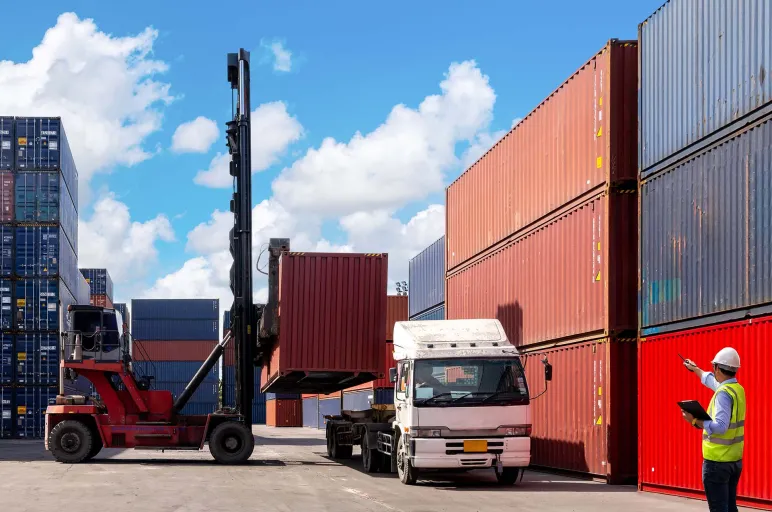
Getting Transportation Procurement Right—Across Land, Water and Air
- Optimize costs by using tracking technology and selecting the most efficient transport modes.
- Leverage technology like TMS, GPS and automation to improve visibility and communication.
- Focus on sustainability by choosing eco-friendly transport options to meet environmental goals.
November 16, 2024 | Procurement Strategy 4 minutes read
Transportation procurement is a multifaceted process influenced by various factors, including the mode of transport—air, water or land.
Each mode has unique challenges and considerations, which procurement teams must address to ensure efficiency -- from cost fluctuations and technological shortcomings to increasing regulatory pressure for sustainability.
To remain competitive, organizations must adopt a strategic, well-informed approach to transportation procurement that spans across air, water, and land. This will ensure optimized operations and cost-effective logistics management.
Key Transportation Procurement Challenges and Considerations
1. Effectively Managing Time and Assets
Managing transportation assets efficiently is critical to optimize costs. For land transport, which includes trucking and rail services, real-time fleet visibility is crucial to avoid route deviations, accidents and natural calamities. All of which can drastically affect delivery times. Air and sea freight add an extra layer of complexity. Factors like port congestion, flight delays and weather conditions all affect delivery schedules. To ensure optimal asset management across all modes, leading businesses choose to employ advanced tracking technologies and assign the appropriate transport mode based on cost, urgency and route limitations.
2. Coping with Cost Hikes
Cost fluctuations in transportation procurement—driven by fuel prices, labor costs, warehousing, and shipping distances—are a constant concern. Air freight, while fast, is generally the most expensive option, sensitive to fuel price volatility and labor shortages. Sea freight, though cost-effective for bulk shipments, can face port congestion and increased fees due to environmental regulations. Land transport, particularly trucking, faces rising driver salaries and fluctuating fuel costs. To navigate these complexities, procurement teams need contracts that account for such variables, ensuring cost mitigation across all modes.
3. Lack of Technology Coupled with Poor Communication Structures
Interestingly, a surprising number of companies still rely on outdated manual processes in transportation procurement. This issue is particularly evident in land freight—where some companies still use telephonic communication for scheduling truck routes—leading to inefficiencies. Lack of real-time updates also impacts the air and sea transport sectors. Here, delays can have a cascading effect throughout the supply chain. Implementing technology such as transportation management systems (TMS), GPS tracking and automated freight management solutions across all modes can help. They can significantly improve communication, scheduling and fleet tracking.
4. Growing Need for Sustainability Risk Assessment
Sea freight contributes significantly to global carbon emissions—making it a focal point for regulatory bodies. Similarly, air freight is facing mounting pressure to reduce its environmental impact—leading to increased scrutiny of fuel usage and emissions. Even land transport—particularly trucking — is affected by new regulations surrounding electric vehicles and low-emission vehicles.
Best Practices in Transportation Procurement
1. Develop a Comprehensive Procurement Strategy
A successful strategy should address logistics needs across all modes of transportation—air, water or land. Clearly defining requirements like capacity, delivery times, geographic coverage and compliance ensures that your transport procurement strategy aligns with business goals and legal standards.
2. Conduct Comprehensive Research and Comparison
It's important to thoroughly research and evaluate transportation providers across air, sea and land. Air freight is perfect for urgent shipments, but it usually comes with a higher price tag. On the other hand, sea freight is more budget-friendly for larger shipments, although it involves longer transit times and possible delays at the ports that should be considered. Similarly, land transport — especially trucking, requires careful consideration of factors like distance, fleet availability and coverage area. By comparing bids from providers across all modes, you can choose the most reliable and efficient option that aligns with your specific requirements.
3. Leverage Transportation Procurement Technology
Technology adoption is essential across all modes. For land transport, GPS tracking and automated fleet management help optimize routes and reduce delays. Air and water freight can benefit from TMS platforms that integrate with global logistics networks to provide real-time tracking, enhance visibility, and improve decision-making processes.
4. Negotiate for Optimal Contracts
Negotiation strategies should vary depending on the mode of transport. Air freight contracts, for instance, may require more flexibility in terms of fuel surcharges. Sea freight contracts, on the other hand, may involve complex negotiations over cargo handling and port fees. Finally, land transport contracts need to consider variable costs like fuel prices and driver wages. Therefore, custom negotiations ensure better terms and more reliable services from transport providers.
5. Sustainability and Compliance Considerations
Regardless of the mode of transport sustainability and Compliance should be at the forefront of transportation procurement decisions. Air freight releases the maximum amount of carbon emissions—but Innovations like sustainable fuels and more fuel-efficient aircraft could be wise options to explore. Sea freight providers adhering to green shipping practices like cleaner fuels can also significantly reduce the carbon footprint. Land transport providers are increasingly turning to electric vehicles and lower-emission trucks. With sustainability being a priority companies can meet regulatory requirements and CSR profiles.
Also Read: How is Logistics Automation Transforming Supply Chains.
Conclusion
The goal of optimizing transportation procurement across is not just limited to cutting costs. It’s also about building a resilient and sustainable supply chain. Best practices like strategy development, leveraging technology and focusing on sustainability can help. This will help leaders to optimize their transportation procurement and stay competitive in a rapidly evolving market.



